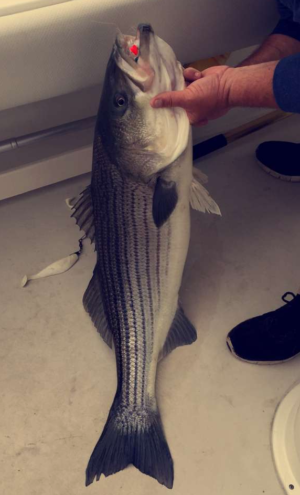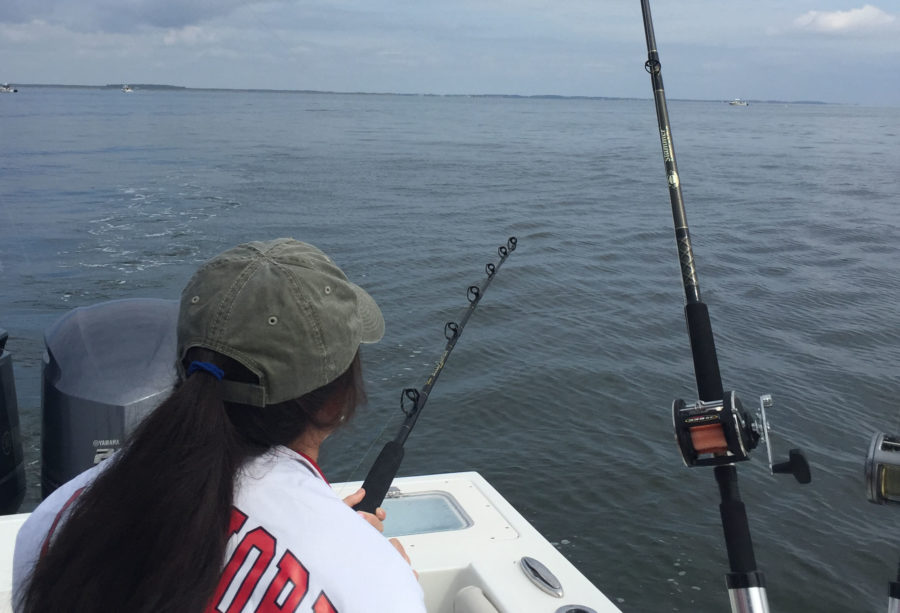Fishing and crabbing are part of summer on the Chesapeake Bay
Bridget Murphy patiently waiting for a bite
May 10, 2016
With summer break just weeks away, some of us are preparing for the fishing and crabbing season.
The weekend of April 29th, my family and I went fishing on the Chesapeake Bay. Many fish there around this time for the striped bass because the larger fish are swimming through the bay to have their babies.
In the summer, the limit of size of your rockfish you can keep–20 inch minimum. The biggest fish we caught last summer in the bay was 24 inches. Last weekend, we caught a 42.1 inch rockfish, a 39.6 inch rockfish and a 40.2 inch rockfish, so it was very exciting to see the difference between our 24 inch rockfish from last summer to these bigger fish.

With the summer months approaching, many fishermen and crabbers are prepping their boats. Families are preparing for many water sports such as tubing and jet-skiing. Our family often crabs, fishes and tubes in the summer on the bay.
The fishing and crabbing forecast for the summer is looking good. Maryland Department of Natural Resources took a survey about the upcoming crabbing season and they say, “the survey indicates a bay-wide crab population of 553 million, a 35-percent increase over last year. This is the fourth highest level in two decades and builds on last year’s 38-percent boost in abundance. Improvements were seen in all age groups of male and female crabs.”
According to the online source, The Last Hurrah, a fishing charter company, “Fishing has been absolutely phenomenal the last few days with fast limits of big fish. Fishing should stay hot for a few weeks.” They explain how the temperatures of the water change as the summer months advance, so there are not as many larger rockfish.
The temperature change also stirs up the bait in the bay, so the upcoming rockfish season will still be successful in the deeper waters. If you can find bait, there are rock fishclose behind.
According to the Chesapeake Bay Foundation, the Bay is a place where 17 million people play, work and adventure.
“When I was younger my uncle had a boat, so my family and I would go fishing every weekend. Now, I don’t fish as much, but my sons and my husband fish every weekend,” says Mrs. Susan Peterson, Fishing Club Advisor and English teacher, about her adventures on the bay.
Looking at the bay’s surface, you would naturally see no real problems with the water besides, maybe, some trash floating around. Yet at the same time, under the surface, the water quality is changing constantly. All of Frederick County, its rivers, creeks and wetlands, are part of the large Chesapeake watershed.
According to the Foundation, there is pollution running off from “agriculture, urban/suburban runoff, vehicle emissions and many other sources.”
“The water is marginal, it could be much better. The Chesapeake Bay Foundation usually does a grading system and it’s usually a C- to a D+.” says Mr. Mark Sunkel, AP Environmental teacher, about the quality of the Chesapeake.
Peterson says her main concern about the bay is “The amount of pollution running off into the bay from farms and what it is doing to the crabs and the other animals.”
Pollution is making it unsafe for people to enjoy the bay, for animals to live and for species’ to thrive. When many people hear the words “Chesapeake Bay”, they think about the famous blue crabs that live in the bay.
Not everyone may realize it, but everything that goes into the waters here in Frederick County can travel all the way out to the bay. Mr. Sunkel explains,” Everything flows down the Monocacy into the Potomac and then into the Chesapeake Bay. We all need to do our parts, everybody in the state of Maryland needs to do their part.”
Many Marylanders enjoy eating the blue crabs in the spring and summer. The blue crabs are threatened by the pollution in the bay, but we can help them and make the water safe again.
Waterfowl Habitat Manager at the Maryland Department of Resources Donald Webster said, “Underwater grass restoration improvement has gone up 28%,” and that helps the life quality of the blue crabs in the bay. Thanks to this restoration and other tactics to help, the crab population has risen.
Save the Bay has a few ideas of how we can all pitch in and save the bay. There are ideas of saving the bay through restoration, within schools, in the court room, with advocacy, in our communities, programs & initiatives, and The Chesapeake Clean Water Blueprint.
Sunkel said, “Each person can do their part, for example, recycling. A lot of the pollution that goes into the bay is either sediment or plastics and if developers put sediment traps around their developments that it can help out a lot.”
“Students and teachers conduct their own research through biological sampling, chemical analysis, and physical measurements.” Save the Bay is the working through schools and letting the new generations join in and help. It is important that the younger generations know what the water in the Chesapeake is like and that they need to keep working to keep pollution out of the bay.
A very easy and productive way that our community in Frederick can help is recycling. Many already recycle in Frederick county but not all know the importance of it. Recycling trash can lead to a positive impact on the bay because the things you recycle are being re-used and they will not end up in land fills where they can go into the bay.
The Chesapeake Bay Foundation has eight suggestions to help the bay.“One of the most common reasons why people don’t recycle is because their location does not offer recycling services. If you’re having trouble finding recycling services in your, enter your area code at Earth911 for a listing of drop-off locations near you.”
The efforts to save the bay since 2010 have paid off. The dead zone in the bay has decreased; the grass growth in the water has increased; and the overall quality of the bay is getting better. If you are interested in joining the efforts to save the bay, click this link. The bay needs our help, are you ready?






